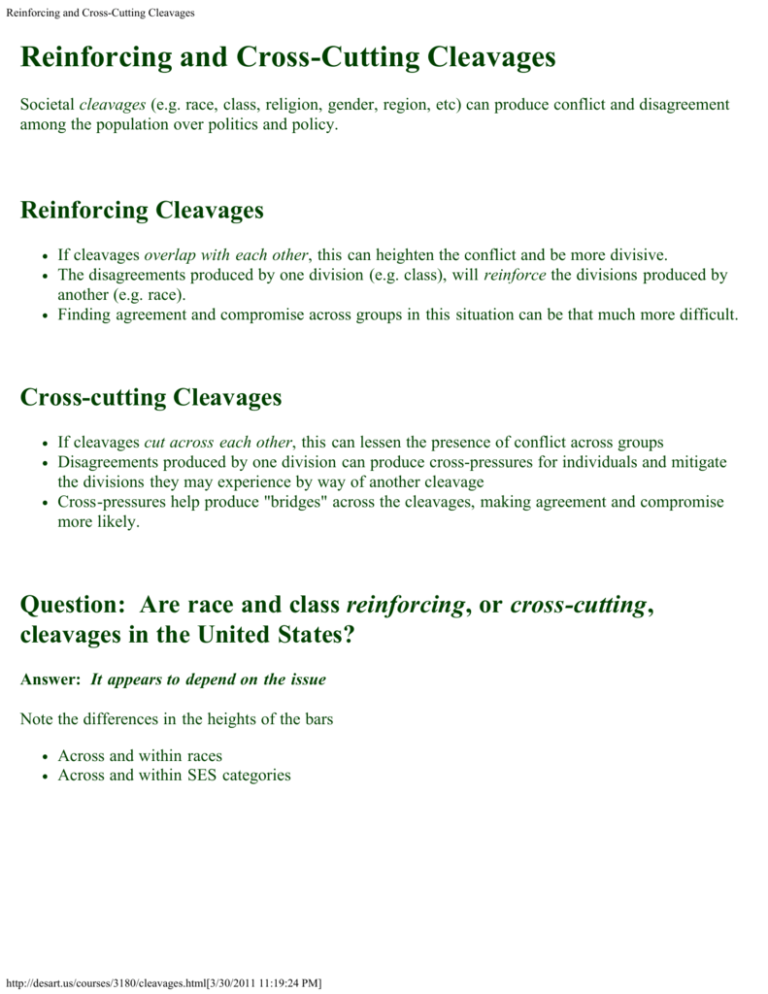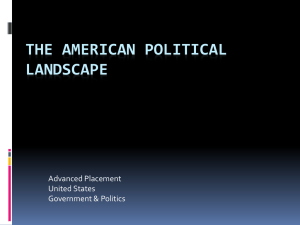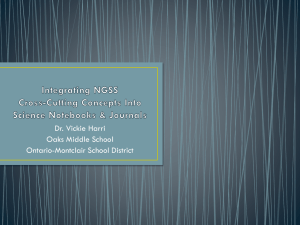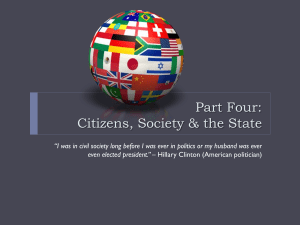Reinforcing & Cross-Cutting Cleavages: Race & Class
advertisement

Reinforcing and Cross-Cutting Cleavages Reinforcing and Cross-Cutting Cleavages Societal cleavages (e.g. race, class, religion, gender, region, etc) can produce conflict and disagreement among the population over politics and policy. Reinforcing Cleavages If cleavages overlap with each other, this can heighten the conflict and be more divisive. The disagreements produced by one division (e.g. class), will reinforce the divisions produced by another (e.g. race). Finding agreement and compromise across groups in this situation can be that much more difficult. Cross-cutting Cleavages If cleavages cut across each other, this can lessen the presence of conflict across groups Disagreements produced by one division can produce cross-pressures for individuals and mitigate the divisions they may experience by way of another cleavage Cross-pressures help produce "bridges" across the cleavages, making agreement and compromise more likely. Question: Are race and class reinforcing, or cross-cutting, cleavages in the United States? Answer: It appears to depend on the issue Note the differences in the heights of the bars Across and within races Across and within SES categories http://desart.us/courses/3180/cleavages.html[3/30/2011 11:19:24 PM] Reinforcing and Cross-Cutting Cleavages This graph shows a slight tendency for class to serve as a cross-cutting cleavage on these issues. The lower SES groups (both white and black) tend to show slightly greater support for social programs to benefit the elderly, health care assistance, and assistance to college students, than their higher SES counterparts. However, blacks (regardless of race) tend to show slightly greater support than whites. http://desart.us/courses/3180/cleavages.html[3/30/2011 11:19:24 PM] Reinforcing and Cross-Cutting Cleavages However, this graph clearly shows that there is indeed a pattern of class serving as a cross-cutting cleavage with race. Note that the level of support among the high SES groups is uniformly lower within racial groups (i.e. high SES black have less support than low SES blacks, and high SES whites have less support than low SES whites). Even so, within classes blacks do tend to show more support for these programs than whites, even though there may still be disagreement within the races across class lines. When the issue is about policy that has a more class-based component (e.g. making sure that everyone who is willing/able to work has a job, providing for a minimum standard of living, working to equalize income differences in society, and providing adequate housing to those who need it) the potential for class to cross-cut with race is greater. http://desart.us/courses/3180/cleavages.html[3/30/2011 11:19:24 PM] Reinforcing and Cross-Cutting Cleavages However, it is a very different picture when the issue is more directly related to race. On matters involving racetargeted policies (policies like affirmative action and anti-discrimination laws) all evidence of class as a cross-cutting cleavage disappears. http://desart.us/courses/3180/cleavages.html[3/30/2011 11:19:24 PM]











